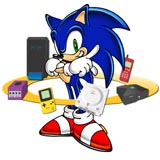Sega: What went Wrong?
 I’m sure most of you are aware that Sega has made an announcement stating that all future production of the Sega Dreamcast will come to a halt. Sega also mentioned that they would be stepping down from a console company to strictly a software development house, with their sites set on bringing their unique talent to their once rival gaming companies. What is strange is the fact that in November, during a presentation for Japanese gaming journalists, Sega clearly stated that the future of Sega does not include “software development for other companies.”
I’m sure most of you are aware that Sega has made an announcement stating that all future production of the Sega Dreamcast will come to a halt. Sega also mentioned that they would be stepping down from a console company to strictly a software development house, with their sites set on bringing their unique talent to their once rival gaming companies. What is strange is the fact that in November, during a presentation for Japanese gaming journalists, Sega clearly stated that the future of Sega does not include “software development for other companies.”
But what exactly happened that could drastically change Sega’s outlook for the future?
Let’s take a step back into time. We’re looking at Sega and Nintendo in the early nineties; Sony was virtually unheard of in the gaming world. It’s the Sega Genesis and the Super NES (Nintendo Entertainment System). But when the time came for plans into the next generation of gaming, I think this is the most critical step in which Sega faltered. Nintendo went ahead and released their Nintendo 64; Sega launched with their Sega Saturn, and the new player in town Sony, launched with their Sony PlayStation. The difference? The Sega Saturn didn’t live to see the next generation, and Sega lost millions of dollars.
Now we fast-forward almost 5 years later. Everyone is anticipating the arrival of the Dreamcast, which by far has the best graphics, sound, memory, etc… to date. But now they have a problem. Nintendo and Sony had both built up substantial user bases, since everyone had either a PS or an N64, but what did Sega have to fall back on? Yep, you guessed it: Nobody. They were forced to market their Dreamcast extensively, while Sony (for instance), doesn’t even need to place an ad on television (have you seen even one Sony endorsed ad on TV), and they’ve already sold a million PS2 systems.
But let’s get back on track. The Dreamcast launches, and it gains some pretty heavy news coverage, the commercials are everywhere, but no one’s buying the damn system? Why? Because they’re sitting at home with they’re extensive PS gaming library and drooling over the arrival of the PS2. Not me, however. I’m drooling over the Gamecube.
But despite this, Sega has managed to create some spectacular game titles. Game quality has never been a problem with Sega, and the titles to follow have only gotten better and better; which brings me into another point. Sega’s own development house had 9-10 firms (named AM2 through to AM10) creating games. But since then some have broken up and launched new development houses with different names. Here are a few…
- Hit Maker (formerly AM3)
- United Game Artists (formerly AM9)
- Wow Ent. (formerly AM1
- Sega Overworks (formerly AM7)
- Amusement Vision (formerly AM4)
- Sega Rosso (formerly AM5)
So what I’m saying is that Sega has less control over them then when they use to. So they could (and probably do) have their sites set on developing for other consoles, which leaves Sega in their dust. And who wants to waste resources and money on a console with no future? Certainly not me.
But the one thing that you can score for the home team is SegaNet. I mean, you have to admire Sega. Companies like Sony are always in a wait-and-see game, while Sega follows through and launches what has to be the first successful online gaming community. You can forget about lag, and the titles that are currently on the market are enough to keep you busy for weeks to come.
However, although I may be talking about a “console with no future”, it doesn’t mean that Sega has completely given up on the Dreamcast. Sega has announced steps to expand the DC market, starting with an “add-on” chip that can be built into other devices. Most of Sega’s partners are still going strong with the Dreamcast, and we’ll be seeing some incredible gaming software before the system goes out.
But for Sega, Japan has always been the hardest nut to crack. Staggering losses in their home country have forced the company to take action. Sega envisions that the company may split three ways 1) online network video game content 2) narrow and broadband electronic services to the online community and 3) location-based entertainment centre’s showing Sega’s content.
Whatever Sega does though, they’re going to have to move fast. With years of experience in the online market and the promising presence of online connect ability ‘outta da box, Microsoft’s X Box is set to take the next generation by storm. And let’s not forget Sony’s still unverified presence online. I can only hope that Sega will still have a presence in the gaming world and find a place in online gaming.
Restored with the Internet Archive's Wayback Machine [1]